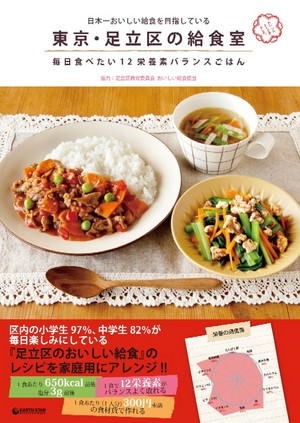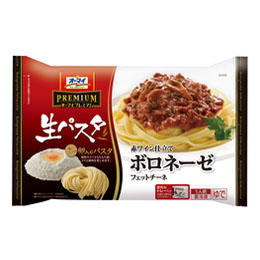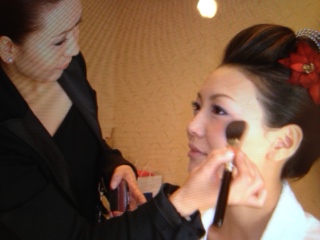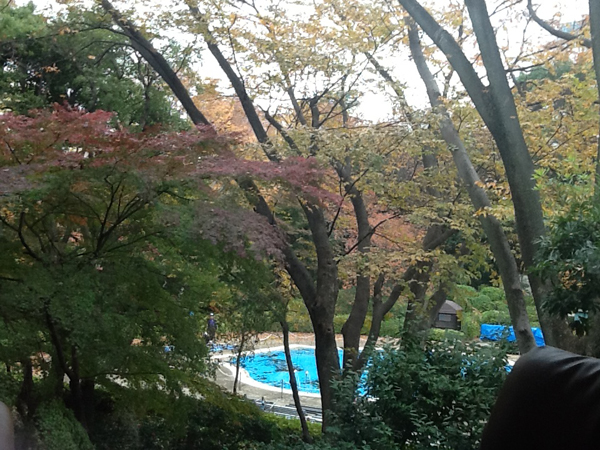 Do you know that School Lunch in Adachi City (Tokyo) has been paid close attention from all over Japan? “Japan’s Most Delicious School Lunch” is the motto of Adachi City. I can tell they have gone for a step ahead compared to typical conservative plans that administration may have. I had a chance to interview the author of this book, who is a subsection chief representing the School Lunch section of Adachi City Office for a radio show the other day.
Do you know that School Lunch in Adachi City (Tokyo) has been paid close attention from all over Japan? “Japan’s Most Delicious School Lunch” is the motto of Adachi City. I can tell they have gone for a step ahead compared to typical conservative plans that administration may have. I had a chance to interview the author of this book, who is a subsection chief representing the School Lunch section of Adachi City Office for a radio show the other day.
As a professional nutritionist, I have been concerned about the school lunch system, in which the cooking is done at a center, and which is usually committed to private companies. Although it was almost a decade ago, school lunch seemed to be inclined to go against food education. A good example is one lunch menu when udon noodle was served with rice. The udon noodle is packaged in a plastic bag which children are required to open to a soup bowl by themselves. Because of the udon noodle, a spork (a spoon the edge of which are shaped like a fork) is prepared instead of chopsticks.
Recently, an attention has been focused on food education in nationwide and school lunch has been developed a trend to have Japanese style menus more. Along with that, a plan also has a goal to educate all children to use chopsticks properly. Among of all the efforts, Adachi City is prominent because the female mayor adopted food education as one of the major policies 5 years ago. Delicious school lunch will make children happy and smile. Now that all the school lunch in Japan are well-balanced and includes all 12 nutrients. I expect it affects on children’s physical and mental health, the sense of taste, and good action of the cerebrum. The salt level in each meal is maintained to be 3g. This is quite low.
The famous ramen noodle restaurants that host a line of people usually serve one bowl of ramen noodle with 5 to 10 grams of salt in it. Once accustomed to such a food, it is natural for children to dislike less salty meals. But it is mandatory that school lunch provided in Adachi City use natural soup stock and seasoning. They have proved that such natural soup stock and seasoning can make delicious, satisfactory meals with low salt level. But how?
If children find school lunch is not their taste, they usually do not eat. So the amount of leftover can tell whether children liked the day’s school lunch or not. All the schools in Adachi City have adopted this method. When small fish, liver, or seaweed such as hijiki and wakame are used for the menu, the leftover simply increases. But in Adachi City where a delicious school lunch is provided, it does not happen. The leftover in the year of 2010 was 5.5% in elementary schools and 10% in junior high schools, which are both relatively low. The figure is even 4% lower owing to the better seasoning, better arrangements of foods, and much more fun lunch time. This is a great outcome of Adachi City’s method. Children eat fish, soy beans, and seaweeds. Each menu includes around 250g of 10 to 15 different kinds of vegetables.
Each meal costs about 254yen, almost as equivalent as a cup of coffee. If we want to use the same ingredients at home, it will probably cost nearly 500yen. I can tell this is almost a miracle that school dietitians and cooks have combined their efforts and passions to make a delicious school lunch. In fact, even though we are living in what is called a “satiation period,” 97% of children have answered that school lunch time is fun. Can you imagine how those children who bear our future on their shoulders are having delicious, fun school lunch with smiles every day? 20 and 30 years later when they grow up, they are healthy and able to eat anything. Moreover they grow up to be able to cook such meals at home. I can imagine the future Japan is full of sophisticated people who have been taught so by traditional Japanese food and elegant manner of chopsticks. Am I thinking too much?
I’m just happy that one book is having an important impact on recent Japanese School Lunch.
 During such a low-economic growth era, we tend to be hesitant to spend our money. Instead, we are more likely to enjoy looking for novel foods in our everyday life. One of the trends I’ve found is that many restaurants now serve fettuccine (noodles in flat strips) with ragu sauce, the beef cheek stewed in wine. To my surprise, I also found it already sold in a frozen pack at a grocery store.
During such a low-economic growth era, we tend to be hesitant to spend our money. Instead, we are more likely to enjoy looking for novel foods in our everyday life. One of the trends I’ve found is that many restaurants now serve fettuccine (noodles in flat strips) with ragu sauce, the beef cheek stewed in wine. To my surprise, I also found it already sold in a frozen pack at a grocery store.
 The other day, I went to help with a volunteer activity to make up handicapped children. They were so excited because they have never had make-up on before. As the make-up went on, they started to have bright smiles on their faces as if roses bloom under the morning sun. We were the ones to provide, but it was us who got deeply impressed by those children more than we had expected.
The other day, I went to help with a volunteer activity to make up handicapped children. They were so excited because they have never had make-up on before. As the make-up went on, they started to have bright smiles on their faces as if roses bloom under the morning sun. We were the ones to provide, but it was us who got deeply impressed by those children more than we had expected. 
 Do you know that School Lunch in Adachi City (Tokyo) has been paid close attention from all over Japan? “Japan’s Most Delicious School Lunch” is the motto of Adachi City. I can tell they have gone for a step ahead compared to typical conservative plans that administration may have. I had a chance to interview the author of this book, who is a subsection chief representing the School Lunch section of Adachi City Office for a radio show the other day.
Do you know that School Lunch in Adachi City (Tokyo) has been paid close attention from all over Japan? “Japan’s Most Delicious School Lunch” is the motto of Adachi City. I can tell they have gone for a step ahead compared to typical conservative plans that administration may have. I had a chance to interview the author of this book, who is a subsection chief representing the School Lunch section of Adachi City Office for a radio show the other day.